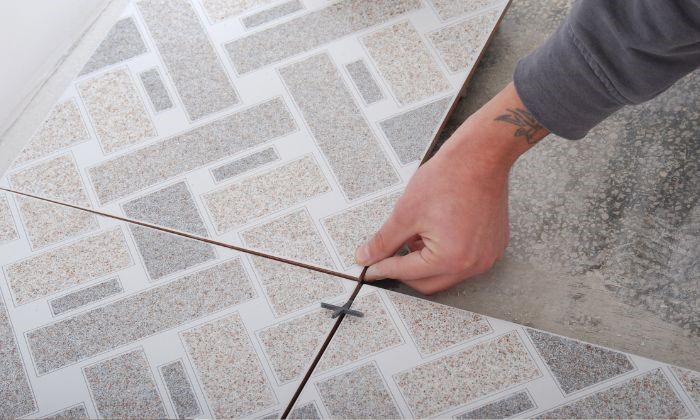Summary
- Choosing the right tile material for high-traffic and wet areas is crucial for durability and safety. For high-traffic zones, opt for tough, wear-resistant tiles like porcelain or natural stone, which can withstand heavy use without damage.
- In wet areas, prioritize slip-resistant tiles such as textured porcelain, ceramic with anti-slip coatings, or certain natural stones to prevent accidents. Additionally, consider water absorption rates—tiles with low porosity are best for wet conditions to avoid moisture damage.
- Proper grout and sealing also enhance longevity and safety. Balancing durability, slip resistance, and maintenance needs ensures optimal tile performance in these challenging environments.
Selecting the right tile material for high-traffic and wet areas in your home or commercial space is a critical decision that impacts durability, safety, aesthetics, and maintenance. Tiles are often the preferred choice in these challenging environments because they combine resilience with style, but not all tiles are created equal. Understanding the properties of various tile materials, their advantages, and limitations can help you make an informed decision that will stand the test of time.
This article explores the best tile materials suited for high-traffic and wet areas, factors to consider when choosing tiles, and tips on purchasing from an online tile store to meet your specific needs.

Tile Material
Understanding the Challenges of High-Traffic and Wet Areas
Before diving into tile types, it’s essential to understand why certain areas require special tile materials.
High-Traffic Areas
High-traffic areas like entryways, kitchens, hallways, commercial lobbies, and public restrooms experience constant footfall. Tiles here must withstand:
- Wear and tear: Scratches, abrasions, and impact damage.
- Stains: From dirt, spilled food or liquids.
- Maintenance: Easy cleaning and minimal upkeep.
- Durability: Long lifespan under heavy use.
Wet Areas
Wet areas include bathrooms, showers, pool surrounds, mudrooms, and kitchens where moisture is a constant factor. Tiles in these locations must offer:
- Water resistance: To prevent water absorption and damage.
- Slip resistance: To reduce accident risk on wet surfaces.
- Mold and mildew resistance: Since moisture promotes microbial growth.
- Durability: Resistant to cracking or warping from water exposure.
Understanding these challenges helps narrow down tile materials that are both functional and aesthetically pleasing.
Common Tile Materials for High-Traffic and Wet Areas
Several tile materials are popular for their durability and suitability in demanding environments. Here are the most common ones:
1. Porcelain Tiles
Porcelain is a subtype of ceramic tile made from finer, denser clay and fired at higher temperatures. It is one of the best choices for both high-traffic and wet areas.
- Durability: Extremely hard and resistant to wear.
- Water Absorption: Less than 0.5%, making it highly water-resistant.
- Maintenance: Easy to clean and doesn’t stain easily.
- Slip Resistance: Can be manufactured with textured surfaces or matte finishes.
- Variety: Comes in various styles, colors, and sizes, including tiles that mimic natural stone or wood.
Porcelain tiles are ideal for commercial spaces like shopping malls and bathrooms, as well as home kitchens and entryways. Their dense composition makes them less prone to cracking and chipping.
2. Ceramic Tiles
Ceramic tiles are made from natural clay but fired at slightly lower temperatures than porcelain. They are often glazed, giving a smooth, shiny surface.
- Durability: Suitable for moderate to high-traffic areas but less hard than porcelain.
- Water Absorption: Higher than porcelain, so better for areas with moderate moisture.
- Maintenance: Easy to clean, but glazed surfaces may chip over time.
- Slip Resistance: Glazed ceramic tiles can be slippery when wet unless treated.
Ceramic tiles are common in residential bathrooms and kitchens, but are less recommended for heavy commercial use or extremely wet areas.
3. Natural Stone Tiles
Natural stone tiles include materials such as granite, slate, marble, travertine, and limestone. They offer a unique, luxurious appearance but come with certain considerations.
- Durability: Varies by stone type. Granite and slate are very durable; marble and limestone are softer and more prone to scratching.
- Water Absorption: Natural stones are porous and require sealing to resist moisture.
- Maintenance: Requires regular sealing and special cleaners to maintain.
- Slip Resistance: Generally good, especially textured stones like slate.
Natural stone tiles are favored for aesthetics and durability but require more upkeep, particularly in wet environments. Their porous nature means water can seep in if not properly sealed, leading to stains or damage.
4. Vinyl Tiles
While not traditional ceramic or stone, vinyl tiles are increasingly popular in wet and high-traffic areas due to affordability and water resistance.
- Durability: Resistant to impact and wear, but can dent or scratch.
- Water Absorption: Waterproof varieties exist.
- Maintenance: Easy to clean and maintain.
- Slip Resistance: Available with textured surfaces for safety.
Vinyl tiles are often used in commercial kitchens, bathrooms, and hospitals where moisture and traffic are high. However, they lack the luxury and longevity of porcelain or stone.
5. Quarry Tiles
Quarry tiles are unglazed ceramic tiles made from natural clay and shale, fired at high temperatures.
- Durability: Very tough and dense, ideal for heavy traffic.
- Water Absorption: Moderately porous, requiring sealing for wet areas.
- Maintenance: Rough surface may be harder to clean, but offers excellent slip resistance.
- Slip Resistance: Very good due to their texture.
Quarry tiles are a traditional choice for commercial kitchens and industrial settings.
Key Factors to Consider When Choosing Tiles for High-Traffic and Wet Areas
Choosing the right tile is more than just selecting a material. You need to weigh multiple factors to ensure the tile fits your specific conditions and preferences.
1. Durability and Hardness
The tile must endure constant foot traffic without cracking or wearing out. Porcelain ranks highest for hardness, followed by quarry tiles and certain natural stones like granite.
The PEI rating (Porcelain Enamel Institute) measures tile hardness on a scale of 1 to 5. For high-traffic areas, look for tiles rated 4 or 5.
2. Water Absorption and Resistance
For wet areas, water resistance is paramount. Porcelain has the lowest water absorption rate, making it perfect for bathrooms and outdoor pool decks. Natural stones must be sealed to enhance water resistance.
3. Slip Resistance
Wet floors are slippery and dangerous, so slip-resistant tiles are essential. Look for tiles with a COF (Coefficient of Friction) rating above 0.6 for safe traction in wet conditions.
Matte finishes, textured tiles, or those with anti-slip coatings provide better grip.
4. Maintenance and Cleaning
Tiles in high-use areas need to be easy to clean and maintain. Porcelain and ceramic tiles are low-maintenance, while natural stones require sealing and specific cleaning products.
5. Aesthetic Appeal
The right tile should complement your design vision. Fortunately, porcelain and ceramic tiles offer endless styles—from classic to modern, mimicking natural textures.
Natural stone delivers unmatched natural beauty but at a higher price and maintenance cost.
6. Budget
Costs vary widely between materials. Porcelain tiles are generally affordable, with premium options available. Natural stones can be expensive, not only for the tile but also for installation and upkeep.
Practical Recommendations for Different Areas
Here’s a breakdown of the best tile choices for common high-traffic and wet areas:
Entryways and Hallways
These areas endure heavy foot traffic and exposure to dirt and moisture. Porcelain tiles with a high PEI rating and textured finish are ideal. Consider darker shades or patterned tiles to hide dirt.
Kitchens
Kitchens are high-traffic and wet zones. Porcelain or glazed ceramic tiles work well. If you prefer natural stone, granite is durable and stain-resistant but requires sealing.
Bathrooms and Showers
Porcelain tiles with matte, slip-resistant finishes are best. For shower floors, smaller mosaic tiles with textured surfaces improve safety. Avoid polished tiles that become slippery when wet.
Commercial Spaces
In commercial lobbies or retail areas, porcelain and quarry tiles excel for their toughness. For restaurants and industrial kitchens, quarry tiles offer slip resistance and durability.
Buying Tiles from an Online Tile Store
With the rise of e-commerce, purchasing tiles from an online tile store has become a convenient option offering many benefits:
Advantages
- Wide Selection: Access to vast varieties of tile materials, colors, patterns, and finishes not always available locally.
- Competitive Pricing: Online stores often provide better prices due to lower overhead costs.
- Customer Reviews: Helpful insights on product quality and usability.
- Convenience: Easy to browse and order from home, with delivery options.
Tips for Buying Tiles Online
- Order Samples: Before buying large quantities, order samples to evaluate texture, color, and slip resistance.
- Check Specifications: Look for PEI ratings, water absorption data, and slip resistance ratings.
- Read Return Policies: Make sure you understand the store’s return or exchange policies.
- Confirm Shipping Costs: Tiles can be heavy, so factor in shipping fees.
- Consult Experts: Many online tile stores offer chat support or design consultation.
Shopping online for tiles allows you to compare many options and find the perfect fit for your high-traffic or wet area needs.
Installation and Maintenance Tips
Choosing the right tile material is only half the battle; proper installation and maintenance ensure longevity.
- Professional Installation: Especially important for natural stone and large porcelain tiles to avoid cracking.
- Use Quality Grout and Sealants: In wet areas, use waterproof grout and regularly reseal natural stone tiles.
- Regular Cleaning: Use recommended cleaners to prevent damage and buildup.
- Address Damage Promptly: Replace cracked or chipped tiles to avoid water infiltration.
Conclusion
Choosing the right tile material for high-traffic and wet areas requires balancing durability, water resistance, safety, aesthetics, and budget. Porcelain tiles stand out as the top all-around choice due to their hardness, water resistance, and versatility. Ceramic tiles work well for moderate use, while natural stones offer luxury at the cost of maintenance. Quarry tiles provide rugged durability and slip resistance for commercial applications, and vinyl tiles offer a budget-friendly, waterproof alternative.
When shopping, an online tile store can be an excellent resource for finding the perfect tile with convenience and variety. Always consider PEI and COF ratings, maintenance needs, and installation practices to ensure your tiles remain beautiful and functional for years to come.
With the right choices, your high-traffic and wet areas will be safe, stylish, and durable, enhancing the value and enjoyment of your space.



